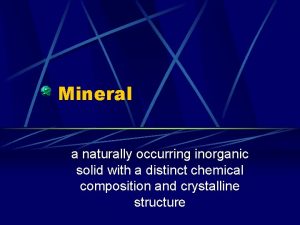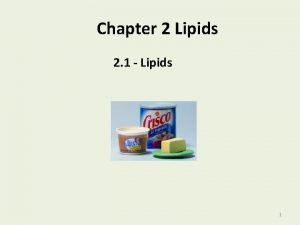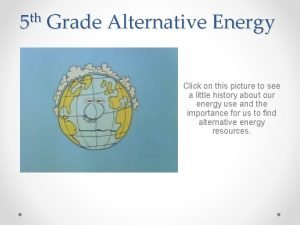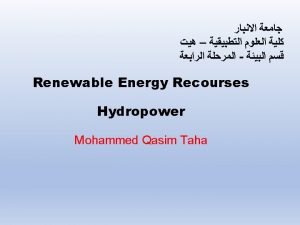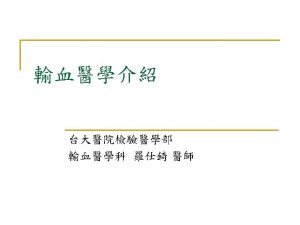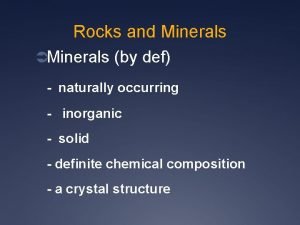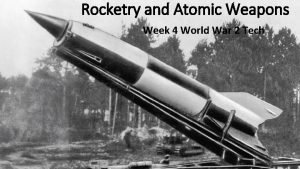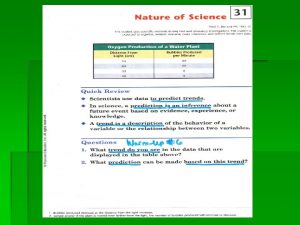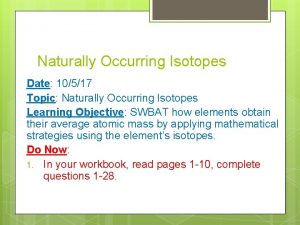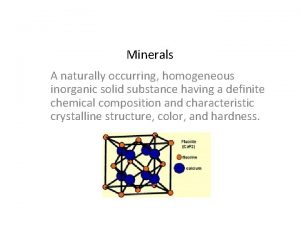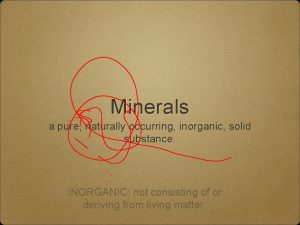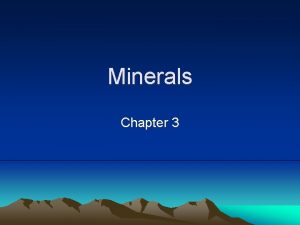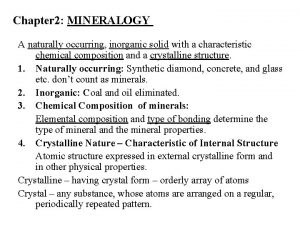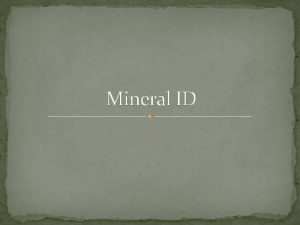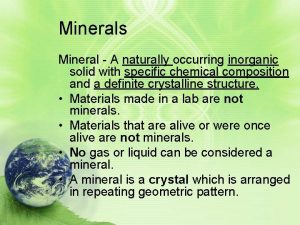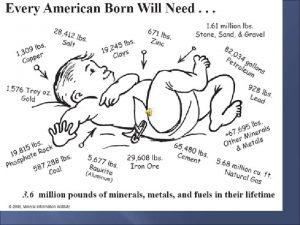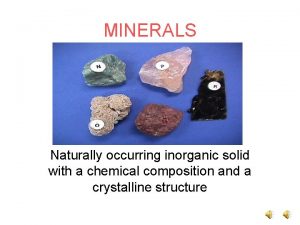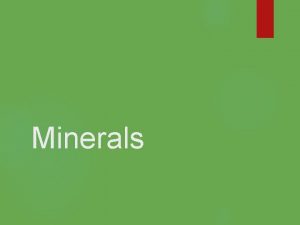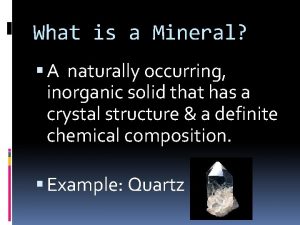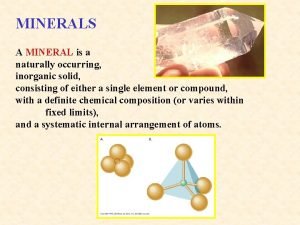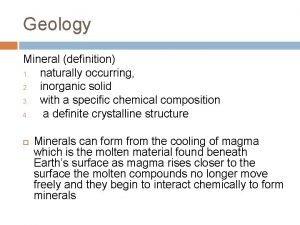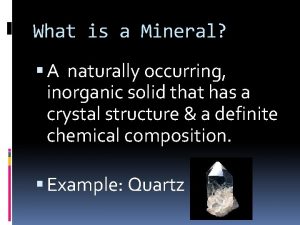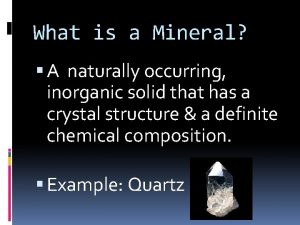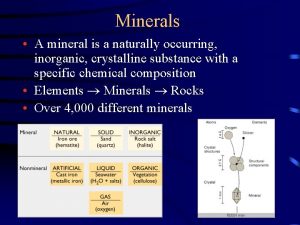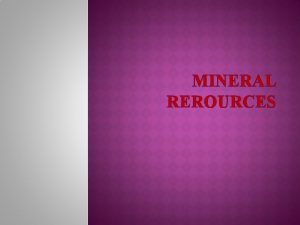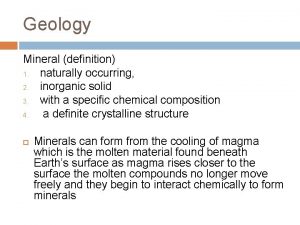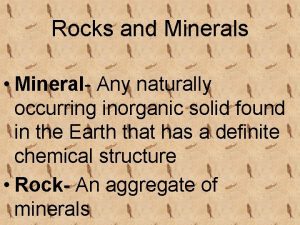1 Naturally occurring 2 Inorganic 3 Solid 4






















- Slides: 22

1. Naturally occurring 2. Inorganic 3. Solid 4. Crystal structure (due to internal arrangement of atoms) 5. Definite chemical composition MINERALS DEFINITION


General Facts about Minerals Between 2 - 3, 000 have been identified A few are “native elements” -- made of only one element, such as sulfur, gold. copper, and graphite (carbon) Most are compounds, especially the silicate group (Si, O). Other important groups are oxides, carbonates, and sulfides.

Less than a dozen are common in most rocks Quartz Feldspar (group) Muscovite (white mica) Biotite (black mica) Calcite Pyroxene Olivine Amphibole (group) Magnetite, limonite, and other iron oxides Pyrite

Silicates Silicon and oxygen are two of the most abundant elements on earth Silicates are the most plentiful minerals on earth They are built around covalent bonds of silicon and oxygen

Silicates can build in a variety of ways O O Si O O O Si O In flat sheets like mica O

Or in crystals 0 0 0 Si 02 0 Si 0 00 Si Si 0 0 0 0 Si 0 0 Or in crystals like quartz

Minerals are identified by their key characteristics or properties Hardness Crystal structure Luster Color Streak Cleavage/fracture Density Special Properties § § § reaction to acid fluorescence salty taste magnetism odor

Mineral Hardness Ability to scratch another mineral Mohs Hardness Scale from 1 (talc) to 10 (diamond) Quartz (most common mineral) is 7


Color results from ability to absorb some wavelengths and reflect others some minerals have characteristics colors others vary due to chemical differences or impurities (atoms mixed inside the main elements)

Luster Describes how light reflects off the surface Main categories are “metallic” and “nonmetallic” Non-metallic includes “dull, ” glassy, ” waxy, ” “pearly”

Streak Color of the powder when rubbed on a “streak plate” (unglazed porcelain) May be same as hand-specimen or different Some paint is based on powdered minerals (streaks).

Density (Specific Gravity) All minerals have density (mass / volume), but some are very dense Examples include galena, magnetite, and gold Specific Gravity is the density of the mineral compared with density of water

Crystal Shape (Form) External structure due to internal arrangement of the atoms Six basic groups of shapes, with about three dozen variations

Mineral cleavage/fracture A mineral that splits easily along flat surfaces when struck hard--this is called mineral cleavage Fracture- Describes how a mineral looks when it breaks apart in an irregular way. A few minerals have both cleavage and fracture

Special Characteristics Many minerals have some special characteristic that helps us identify that mineral.

Special Characteristics-Fluorescence Some minerals will glow when placed under short-wave or long-wave ultraviolet rays Franklin and Ogdensburg NJ are famous for their fluorescent minerals

Special Characteristic-Salty Taste DO NOT TASTE the MINERALS! Halite -it will taste salty, just take my word for it.

Special Characteristics-Magnetism Many iron minerals will produce an invisible magnetic force field “Lodestone” was used by Vikings more than 1, 000 years ago as compasses http: //www. minerals. net/mineral/oxides/magnetit/magneti 4. htm

Special Propertiesreacts to acid Calcite will bubble up when acid is poured on it.

Common uses include: Aluminum--packaging, transport, building Beryllium--gemstones, fluorescent lights Copper--electric cables, wires, switches Feldspar--glass and ceramics Iron--buildings, automobiles, magnets Calcite--toothpaste, construction
 Naturally occurring inorganic solid
Naturally occurring inorganic solid Naturally occurring fatty acids
Naturally occurring fatty acids Geothermal energy advantages and disadvantages
Geothermal energy advantages and disadvantages Naturally occurring areas of hydrothermal resources
Naturally occurring areas of hydrothermal resources Naturally occurring areas of hydrothermal resources
Naturally occurring areas of hydrothermal resources Reverse typing
Reverse typing Minerals def
Minerals def Largest naturally occurring element
Largest naturally occurring element Is a naturally occurring association among specific things
Is a naturally occurring association among specific things Largest naturally occurring element
Largest naturally occurring element Find the probability of z occurring in the indicated region
Find the probability of z occurring in the indicated region What process is occurring
What process is occurring Find the probability of z occurring in the indicated region
Find the probability of z occurring in the indicated region Amorphous vs crystalline
Amorphous vs crystalline Crystalline solid and amorphous solid
Crystalline solid and amorphous solid Sifting separating mixtures
Sifting separating mixtures Covalent network solid vs molecular solid
Covalent network solid vs molecular solid Ex of solid solution
Ex of solid solution Anisotropic meaning in chemistry
Anisotropic meaning in chemistry Crystalline solid
Crystalline solid When a solid completely penetrates another solid
When a solid completely penetrates another solid Crystalline solids
Crystalline solids When a solid completely penetrates another solid
When a solid completely penetrates another solid
